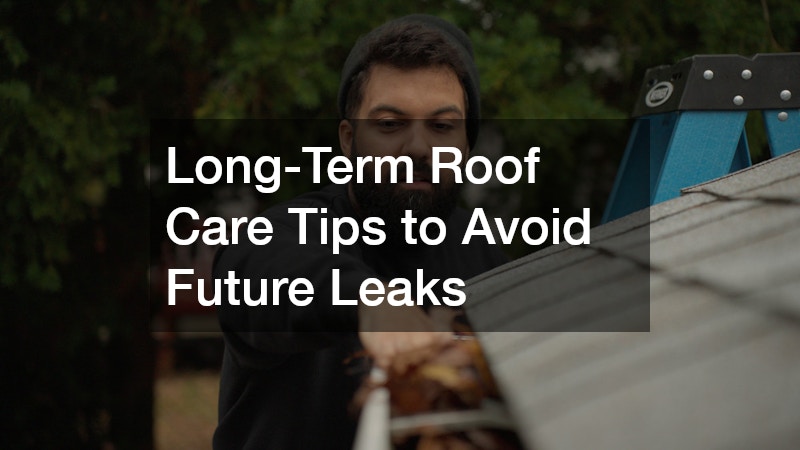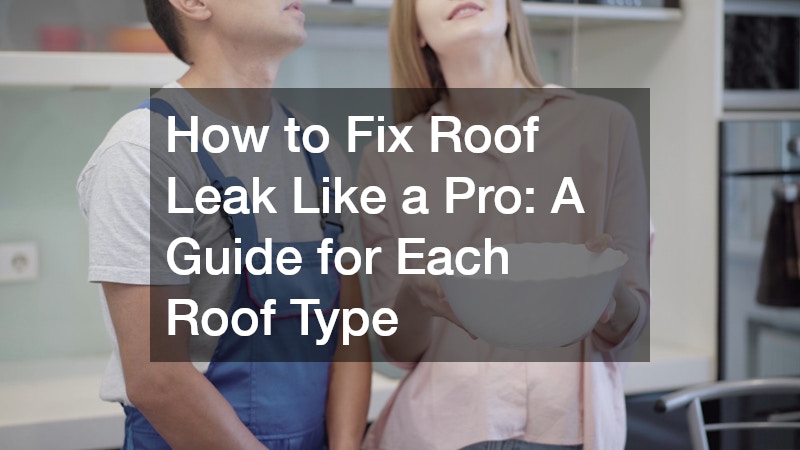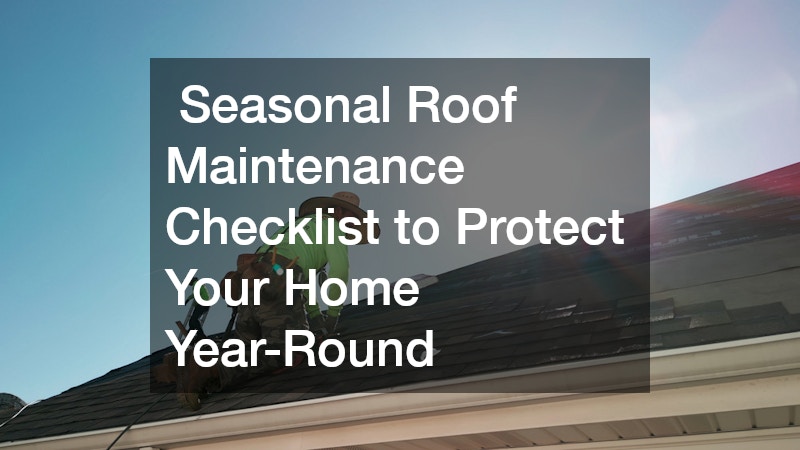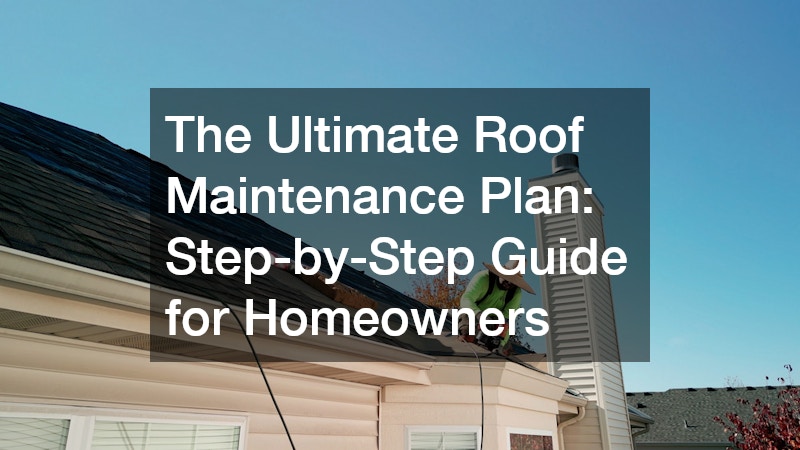When your roof springs a leak, it can quickly turn from a minor nuisance to a serious structural issue. Whether it’s a small drip or a steady stream during a storm, knowing how to fix a roof leak like a pro saves you money, stress, and potential damage. While some fixes are DIY-friendly, others require specialized tools or expertise, depending on your roof type.
This comprehensive guide will walk you through roof leak solutions tailored for asphalt shingles, metal roofs, tile roofs, and flat roofs, equipping you with the knowledge you need to tackle leaks with confidence.
Why Roof Leaks Happen and How to Spot Them Early

Roof leaks are typically the result of aging materials, weather damage, or poor installation. The sooner you catch a leak, the better chance you have of avoiding costly repairs.
Common Causes of Roof Leaks:
- Cracked or missing shingles
- Damaged flashing around chimneys and vents
- Clogged gutters
- Ice dams
- Aging or improperly sealed seams on flat or metal roofs
Signs of a Roof Leak:
- Water stains on ceilings or walls
- Damp attic insulation
- Mold or mildew smells
- Dripping sounds after rain
Pro tip: Inspect your roof at least twice a year and after major storms to catch damage early.
How to Fix a Roof Leak in Asphalt Shingles
Asphalt shingles are the most common residential roofing material in North America. They’re durable, cost-effective, and relatively easy to repair.
Tools and Materials You’ll Need:
- Roofing cement or roof patch
- Replacement shingles
- Pry bar and utility knife
- Roofing nails and a hammer
- Ladder and safety gear
Step-by-Step Repair Process:
- Locate the leak. Check for damaged or missing shingles and water stains in the attic.
- Remove the damaged shingles. Carefully lift the surrounding shingles and use a pry bar to remove nails.
- Install new shingles. Slide a new shingle into place, nail it down, and seal the edges with roofing cement.
- Seal exposed nails. Apply roofing cement to protect the new nails from weather damage.
Tip: Perform shingle repairs on dry days and avoid walking on the roof when it’s wet or icy.
How to Fix a Roof Leak in a Metal Roof
Metal roofs are known for their longevity and weather resistance, but they’re not immune to leaks, especially around seams and fasteners.
Common Leak Sources on Metal Roofs:
- Loose or missing screws
- Worn-out rubber washers
- Cracked sealant
- Rusted panels or flashing
How to Repair It:
- Inspect fasteners. Tighten any loose screws and replace missing ones.
- Seal gaps. Use a butyl tape or metal roof sealant to fix leaks around screws or seams.
- Patch rust holes. Clean the area, apply metal primer, and use a patch kit with roofing tape and sealant.
- Replace flashing if needed. Damaged flashing around chimneys or skylights should be removed and replaced using sealant and screws.
Safety note: Metal roofs can be very slippery. Always use a roof harness and non-slip shoes.
How to Fix Roof Leak in a Tile Roof
Tile roofs—whether clay, concrete, or synthetic—are beautiful and durable but require special handling during repairs to avoid breaking additional tiles.
What You’ll Need:
- Replacement tiles
- Roofing nails or clips
- Mortar or roofing adhesive
- Ladder and gloves
Steps to Repair a Leak:
- Identify cracked or broken tiles. Use a ladder and examine the leak’s location in relation to ceiling stains or attic moisture.
- Lift the surrounding tiles. Carefully raise the tiles around the damaged one using a flat pry bar.
- Replace the tile. Slide in a new tile and secure it with a dab of roofing adhesive or a tile clip if the style requires it.
- Seal mortar caps. For ridge or hip tiles, reapply mortar to seal any cracks.
Tip: If you can’t find matching tiles, consider taking one to a roofing supply store or salvage yard.
How to Fix a Flat Roof Leak Like a Pro
Flat roofs are commonly found on modern homes and extensions. They’re vulnerable to pooling water and membrane degradation, making regular maintenance essential.
Flat Roof Leak Warning Signs:
- Ponding water
- Blistered or cracked membrane
- Soft spots when walking
- Visible seams or punctures
What You’ll Need:
- Roofing membrane patch kit or liquid rubber sealant
- Utility knife and roller
- Roof primer (optional)
- Roof brush for cleaning
Repair Steps:
- Clean the affected area. Use a brush to remove debris and let the surface dry.
- Cut and patch the membrane. Trim a patch to fit over the hole, apply adhesive, and roll it in place.
- Seal the edges. Use a waterproof roof sealant around the patch for extra protection.
- For larger areas, consider applying a liquid membrane coating over the entire section.
Pro tip: Many flat roof products require dry, warm weather for proper curing.
Temporary Fixes for Emergency Roof Leaks
If a leak starts during a storm or you can’t repair it right away, here are short-term solutions to protect your home:
- Tarp your roof. Use a heavy-duty tarp secured with boards or bricks to cover the leak.
- Use roof sealant tape. This is a waterproof tape that can plug small gaps in metal or membrane roofs.
- Plug the leak from the attic. Place a bucket under the drip and use a roofing patch or spray foam as a temporary barrier.
Remember, these are temporary fixes only. Always follow up with a proper repair.
When to Call a Professional Roofer
While many roof leaks can be handled with a bit of DIY know-how, some situations call for expert help:
- Leaks that recur after repair
- Large-scale storm damage
- Mold in the attic or insulation
- Structural sagging or rotting wood
- Roofing material under warranty
Professional roofers can also perform infrared inspections to detect moisture you can’t see. Hiring a pro is an investment in your home’s safety and longevity.
Preventing Future Roof Leaks
Proactive maintenance is the best defense against roof leaks. Here’s what you can do to keep your roof in top shape:
Seasonal Roof Maintenance Checklist:
- Inspect and clean gutters in spring and fall
- Trim overhanging branches
- Check flashing and sealant around vents and chimneys
- Replace missing or loose shingles
- Examine attic insulation for moisture
Long-Term Prevention Tips:
- Schedule a professional inspection every 2-3 years
- Consider applying a roof sealant every 5-10 years
- Upgrade old materials with more leak-resistant options like synthetic underlayment
Safety First: Precautions to Take Before Roof Repair
Repairing a roof leak may sound simple, but without the proper precautions, it can become dangerous. Every year, thousands of accidents occur due to slips and falls on rooftops. Stay safe by following these safety guidelines:
- Avoid wet or icy conditions. Always wait until the roof is dry to perform any work.
- Use a harness system. Secure yourself with a roof harness and anchor.
- Set up the ladder properly. It should extend at least 3 feet above the roof edge and be positioned on solid ground.
- Work with a partner. Never do roof repairs alone—always have someone nearby in case of emergency.
- Wear appropriate gear. Use non-slip shoes, gloves, and eye protection.
When in doubt, hire a professional roofer who is licensed, insured, and equipped for high-risk repairs.
What to Do If You Need to File a Roof Leak Insurance Claim
If your roof leak is due to storm damage, fallen debris, or other covered perils, homeowners’ insurance may cover the cost of repairs. Follow these steps to improve your chances of a successful claim:
- Document the damage. Take clear photos of the affected area inside and out.
- Save repair receipts. Even temporary fixes count as proof of effort to mitigate further damage.
- Contact your insurer quickly. Report the leak as soon as you notice it.
- Get a professional inspection. Some insurance companies require a licensed roofer to assess the damage.
- Review your policy. Understand what’s covered (e.g., sudden events) versus what’s not (e.g., general wear and tear).
Insurance can ease the financial burden—just make sure to follow all policy guidelines closely.
Long-Term Roof Care Tips to Avoid Future Leaks

Preventing leaks is far easier and cheaper than fixing them. Roof maintenance should be part of your regular home care routine. Here’s how to keep your roof leak-free for years to come:
- Inspect twice a year. Do visual checks in spring and fall for signs of damage or wear.
- Clear gutters and downspouts. Blocked drainage causes water to back up and seep under shingles.
- Trim trees nearby. Overhanging branches can damage roofing materials or create moisture pockets.
- Reapply sealant. Around chimneys, vents, and flashing, every few years as needed.
- Schedule a professional inspection. Every 2–3 years, especially before storm seasons.
Staying proactive will help extend the lifespan of your roof and protect your home from costly water damage.
FAQ: How to Fix Roof Leak Like a Pro
Q: Can I fix a roof leak from the inside only?
A: You can apply a temporary patch inside, but it won’t stop the water from entering. A permanent fix requires external repair.
Q: How much does it cost to fix a roof leak?
A: DIY repairs may cost $50–$150 in materials. Professional fixes range from $200 to $1,000+, depending on the damage and roof type.
Q: What if the leak is around the skylight?
A: Check for damaged flashing or sealant. Reapply flashing tape or replace seals around the skylight frame.
Q: Should I repair a roof myself or hire a pro?
A: Simple repairs like replacing a few shingles are doable. For complex materials (tile, metal) or large leaks, hire a licensed roofer.
Conclusion: Act Fast, Fix Smart
Learning how to fix roof leak like a pro helps you respond quickly when your roof lets water in. By understanding the unique challenges of each roof type and having the right tools and techniques, you can handle many repairs yourself or make informed decisions when hiring a roofer. Roof leaks don’t have to lead to disaster—just be proactive, stay safe, and know when it’s time to call for help.




